The 6-D model of national culture by Geert Hofstede
- Get link
- X
- Other Apps
The 6-D model of national culture
Geert Hofstede, assisted by others, came up with six basic issues that society needs to come to term with in order to organize itself. These are called dimensions of culture. Each of them has been expressed on a scale that runs roughly from 0 to 100.
Dimension maps of the world: Individualism
Each dimension has been derived by comparing many, but not all, countries in the world. The findings can be summarized into six world maps of the distribution of that dimension. Of course, in reality there can be quite a bit of within-country variation; these maps should be seen as rough 'climate maps' of culture.
Individualism
Individualism is the extent to which people feel independent, as opposed to being interdependent as members of larger wholes.
Individualism does not mean egoism. It means that individual choices and decisions are expected. Collectivism does not mean closeness. It means that one "knows one's place" in life, which is determined socially. With a metaphor from physics, people in an individualistic society are more like atoms flying around in a gas while those in collectivist societies are more like atoms fixed in a crystal.
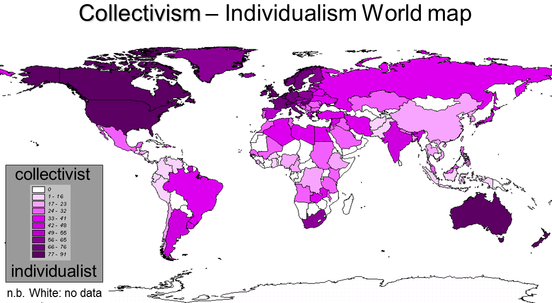
Power Distance
Power Distance is the extent to which the less powerful members of organizations and institutions (like the family) accept and expect that power is distributed unequally.
This dimension is thought to date from the advent of agriculture, and with it, of large-scale societies. Until that time, a person would know their group members and leaders personally. This is not possible where tens of thousands and more have to coordinate their lives. Without acceptance of leadership by powerful entities, none of today's societies could run.
Power Distance is the extent to which the less powerful members of organizations and institutions (like the family) accept and expect that power is distributed unequally.
This dimension is thought to date from the advent of agriculture, and with it, of large-scale societies. Until that time, a person would know their group members and leaders personally. This is not possible where tens of thousands and more have to coordinate their lives. Without acceptance of leadership by powerful entities, none of today's societies could run.
Dimension maps: Power Distance
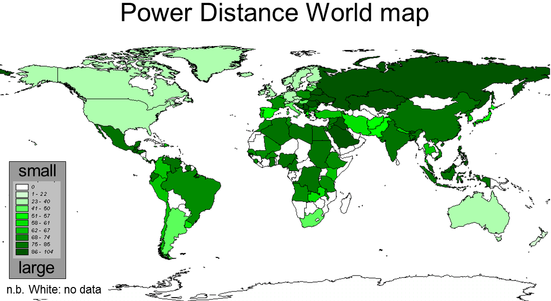
Masculinity
Masculinity
Masculinity is the extent to which the use of force in endorsed socially.
In a masculine society, men are supposed to be tough. Men are supposed to be from Mars, women from Venus. Winning is important for both genders. Quantity is important and big is beautiful. In a feminine society, the genders are emotionally closer. Competing is not so openly endorsed, and there is sympathy for the underdog.
This is NOT about individuals, but about expected emotional gender roles. Masculine societies are much more openly gendered than feminine societies.
Masculinity
Masculinity is the extent to which the use of force in endorsed socially.
Masculinity is the extent to which the use of force in endorsed socially.
In a masculine society, men are supposed to be tough. Men are supposed to be from Mars, women from Venus. Winning is important for both genders. Quantity is important and big is beautiful. In a feminine society, the genders are emotionally closer. Competing is not so openly endorsed, and there is sympathy for the underdog.
This is NOT about individuals, but about expected emotional gender roles. Masculine societies are much more openly gendered than feminine societies.
Dimension maps: Masculinity
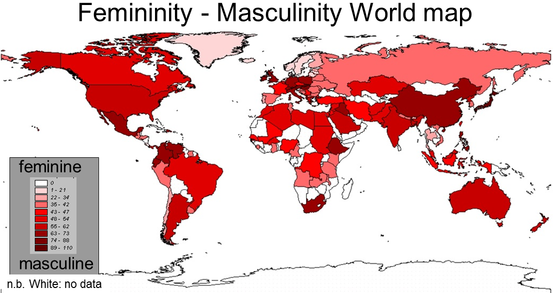
Uncertainty Avoidance
Uncertainty avoidance deals with a society’s tolerance for uncertainty and ambiguity.
Uncertainty avoidance has nothing to do with risk avoidance, nor with following rules. It has to do with anxiety and distrust in the face of the unknown, and conversely, with a wish to have fixed habits and rituals, and to know the truth.
Uncertainty avoidance deals with a society’s tolerance for uncertainty and ambiguity.
Uncertainty avoidance has nothing to do with risk avoidance, nor with following rules. It has to do with anxiety and distrust in the face of the unknown, and conversely, with a wish to have fixed habits and rituals, and to know the truth.
Uncertainty avoidance has nothing to do with risk avoidance, nor with following rules. It has to do with anxiety and distrust in the face of the unknown, and conversely, with a wish to have fixed habits and rituals, and to know the truth.
Dimension maps: Uncertainty Avoidance
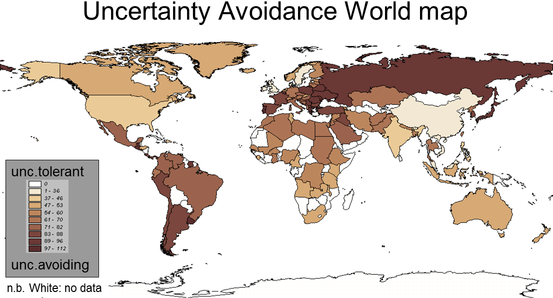
The last two dimensions
The last two dimensions were found later, and in different studies, than the first four. This is why different countries appear on the world maps. These maps are taken from the 2007 book "Why we are different and similar" by Michael Minkov. In our 2010 book they are re-scaled to a 0-100 format. The scale is also reversed for Flexhumility (long-term orientation, blue on the map) versus monumentalism (short-term orientation, orange on the map).
Remember, the numbers do not really 'mean' anything. They are just there for convenience. The world-wide pattern is what matters.
Long-term orientation
Long-term orientation deals with change.
In a long-time-oriented culture, the basic notion about the world is that it is in flux, and preparing for the future is always needed. In a short-time-oriented culture, the world is essentially as it was created, so that the past provides a moral compass, and adhering to it is morally good. As you can imagine, this dimension predicts life philosophies, religiosity, and educational achievement.
Long-term orientation deals with change.
In a long-time-oriented culture, the basic notion about the world is that it is in flux, and preparing for the future is always needed. In a short-time-oriented culture, the world is essentially as it was created, so that the past provides a moral compass, and adhering to it is morally good. As you can imagine, this dimension predicts life philosophies, religiosity, and educational achievement.
In a long-time-oriented culture, the basic notion about the world is that it is in flux, and preparing for the future is always needed. In a short-time-oriented culture, the world is essentially as it was created, so that the past provides a moral compass, and adhering to it is morally good. As you can imagine, this dimension predicts life philosophies, religiosity, and educational achievement.
Dimension maps: Long-term Orientation
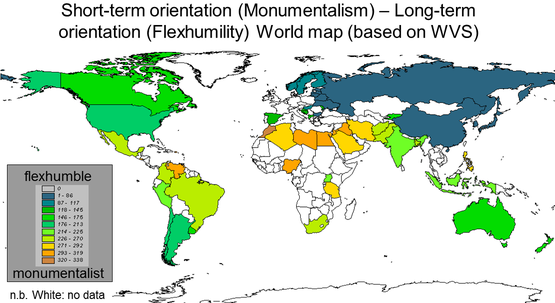
Indulgence
Indulgence is about the good things in life.
In an indulgent culture it is good to be free. Doing what your impulses want you to do, is good. Friends are important and life makes sense. In a restrained culture, the feeling is that life is hard, and duty, not freedom, is the normal state of being.
Dimension maps: Indulgence
- Get link
- X
- Other Apps
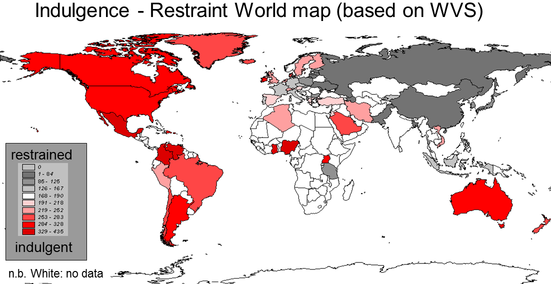
Comments
Post a Comment
Please share your valuable comments and thoughts on this article. Thanks!